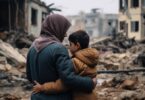Over 26 million people live in Australia, which is the smallest continent on the planet. It’s home to some of the world’s most beautiful ecosystems, like the Great Barrier Reef, the Blue Mountains, and the Daintree Rainforest. It was also colonized by the British, which used it as a penal colony from the late 18th century until the mid-19th century. Today, it is a sovereign country with its own social issues. Here are 15 examples:
| No. | Topic |
|---|---|
| 1 | Poverty |
| 2 | Rights of asylum seekers and refugees |
| 3 | Indigenous rights |
| 4 | Disability rights |
| 5 | LGBTQ+ rights |
| 6 | Gender equality |
| 7 | Violence against women |
| 8 | Incarceration of children |
| 9 | Healthcare access in prisons |
| 10 | Rights of older people |
| 11 | Housing affordability |
| 12 | Houselessness |
| 13 | Mental health |
| 14 | Loss of biodiversity |
| 15 | Wildfires |
#1. Poverty
In 2022, a report on poverty found that 1 in 8 people, including 1 in 6 children, were living in poverty. Australia is one of the world’s richest countries, but over 3 million people struggle to pay basic bills. Income support would make a big difference. During the COVID-19 lockdowns, an economic support program lifted 645,000 people (245,000 of those people were children) above the poverty line. These supports were temporary, but if they became permanent, Australia could reduce poverty very effectively.
#2. Rights of asylum seekers and refugees
When asylum seekers and refugees come to Australia without a valid visa, they’re held in immigration detention until they get a visa or are removed from Australia. There is no limit to how long someone can be detained, so thousands of asylum seekers and some recognized refugees are held in centers around the country. Australia also uses an offshore processing system. Under this system, asylum seekers and refugees are taken to camps in places like Nauru and Papua New Guinea. Families and individuals live in inadequate conditions, sometimes for years. Human Rights Watch has called Australia’s offshore system “abusive and costly.” Since 2013, at least 12 refugees and asylum seekers have died in Australia’s offshore processing system. Six took their own lives.
#3. Indigenous rights
When it comes to Indigenous rights, Australia’s history is full of abuse and discrimination. From the mid-1800s to the 1970s, government policies took children from their families in a period known as “The Stolen Generations.” The legacy of racism and discrimination continues today. Despite making up just 3.8% of the population, Indigenous Australians are “overrepresented” in the criminal justice system. In 2021, at least 11 Indigenous people died in custody due to abuse and/or medical neglect. Indigenous people are also more likely to receive poor education and die young. Australia has the opportunity to protect Indigenous rights with referendums like the “Voice to Parliament,” which would enshrine Aboriginal and Torres Strait Islander people in the constitution and create an advisory body.
#4. Disability rights
The Disability Discrimination Act, which passed in 1992, makes it illegal to discriminate against someone based on their disability. It covers areas like employment, education, public services, and more. Temporary and permanent disabilities are also covered. According to a research paper, however, Australia’s interpretation of the UN’s Convention on the Rights of Persons with Disabilities prevents reform and allows human rights violations to thrive. Examples of violations include forced medical interventions and indefinite detention. Children and people in prisons face some of the worst abuse and discrimination.
#5. LGBTQ+ rights
Australia has many laws regarding LGBTQ+ rights and protections, but the system is far from perfect. According to reporting from The Guardian, anti-discrimination laws across the country are “patchy.” There are broad exemptions, especially for religious groups, which can open the door to discrimination and bigotry. Victoria, South Australia, and Western Australia don’t even have laws that protect LGBTQ+ people from vilification. There are also no federal laws that outlaw vilification based on gender or sexuality. To protect the LGBTQ+ community, Australia needs to strengthen its existing laws and expand protections.
#6. Gender equality
Generally, Australia is a safe and welcoming place for most women, but it still hasn’t achieved gender equality. According to the Australian Human Rights Commission, women in Australia are paid 17.5% less than men doing the same work. The causes include gender stereotypes and low pay for jobs historically performed by women, like social work. Differences in education and work experience, a lack of female leadership, discrimination, and a lack of accommodations for families are other causes.
#7. Violence against women
While Australia ranks high on lists of safest countries for women, violence against women is still an issue. According to the Australian Human Rights Commission, 1 in 3 Australian women will experience violence in an intimate relationship. 1 in 5 women have experienced sexual violence since turning 15 years old. Indigenous women face a higher risk. Research shows they’re 12 times more likely to be victims of assault than non-Indigenous women. Violence is often perpetuated by partners or husbands.
#8. Incarceration of children
Currently, Australia’s age of criminal responsibility is just 10 years old, while the international recommendation is 14 years old. Hundreds of kids are imprisoned each year. In one case, a 13-year-old Indigenous Australian boy spent 45 days in solitary confinement, despite being held for minor offenses. In another case, a 13-year-old with developmental disabilities spent 78 days in a cell for 20 hours a day. These cases could violate the boys’ rights to fresh air and exercise. The cases are not uncommon, either. According to data, overcrowding in juvenile prisons means children – mostly Indigenous children- are often moved to adult prisons. Kids in adult prisons face a high risk of sexual abuse, assault, and suicide.
#9. Healthcare access in prison
Australia uses Medicare. It’s a single-payer, universal healthcare program that covers all Australian citizens and residents. Groups like veterans and Indigenous Australians can access special programs, but there’s one demographic that’s excluded: people in prison. Many human rights experts believe this exclusion constitutes a human rights violation. During COVID-19, the state was slow to give prisoners vaccines despite their heightened risk for the disease due to poor ventilation, an inability to social distance, inadequate sanitation and hygiene, and other factors. People in prison also lack adequate mental health services. In 2018, 40% of jail entrants had a mental health condition, while mental health services in prison were “severely underfunded.” Without access to Medicare, it’s much harder for people in prison to get the healthcare they need.
#10. Rights of older people
Australia’s population is aging, which opens the door to systemic discrimination and inadequate care. In 2021, the Royal Commission into Aged Care Quality And Safety released a report recommending “fundamental reform” of the aged care system. Specific changes included increased accountability for human rights violations, minimum staffing requirements, and increased access to home and community support services. COVID-19 revealed cracks in the system, but it will take significant changes to improve Australia’s aged care services.
#11. Housing affordability
It’s getting more and more expensive to buy and rent housing in Australia. According to a report by PropTrack, which analyzes the real estate market, a household earning an average income would need to spend a third of their income on mortgage repayments for a median-priced home. Increasing home prices and rising mortgage rates are two reasons for housing unaffordability. Tasmania, which has historically had the most affordable homes, is now a place where a typical-income household can only afford 5% of homes sold. Young people and first-time home buyers are some of the hardest hit.
#12. Homelessness
On any given night, around 1 in 200 Australians don’t have a place to sleep. According to data, 1 in 3 houseless Australians are under 18 years old. Young people are especially vulnerable as it’s difficult to get affordable, long-term housing. Domestic violence is the biggest driver of homelessness in Australia, while other causes include unemployment, poverty, and addiction. Most people experiencing homelessness are in Sydney, Melbourne, Perth, and Brisbane, which are Australia’s largest cities.
#13. Mental health
According to the Australian government, over 2 in 5 Australians between 16 and 85 years old have experienced a mental disorder at some point in their lives. Anxiety is the most common disorder, followed by depression and substance abuse. While anyone can experience poor mental health, 24% of the Indigenous Australian population reported a mental health or behavioral condition in 2018-2019. Mental illness still faces stigma in Australia, which makes it even harder for people to get the help they need. Reducing stigma, making it easier to access care, and addressing the roots of poor mental health are all necessary steps.
#14. Loss of biodiversity
“Biodiversity” refers to the variety of life on earth, including plants, animals, and microorganisms. It’s essential to a healthy planet. Australia is home to some of the world’s most unique ecosystems and species. Around 82% of animals and 93% of frogs in Australia only exist there. Tragically, the human impact on biodiversity has been catastrophic. Pollution, resource exploitation, and other issues threaten areas like the Great Barrier Reef, which is the world’s largest coral reef system. Currently, Australia has the worst mammal extinction rate in the world. Preserving Australia’s biodiversity is essential to its future.
#15. Wildfires
Australia is known for its brutal wildfire season. Climate change has made it worse. One fire, which burned through Australia’s summer from June 2019 to January 2020, released smoke levels comparable to a major volcanic eruption. According to research, the smoke from these catastrophic fires could have contributed to a rare triple La Nina weather event, which affected other continents. The fires, known as the Black Summer Fires, also destroyed an area equivalent to half of California and killed 33 people. Children and pregnant people are among those most affected by lingering health effects, such as premature labor, low birth weight, impaired lung development, and other ongoing issues. Australia is one of the biggest greenhouse gas emitters in the world, so new, strict regulations on emissions are vital.
If you want to get active on the issues above, consider joining one of the many NGOs in Australia.












